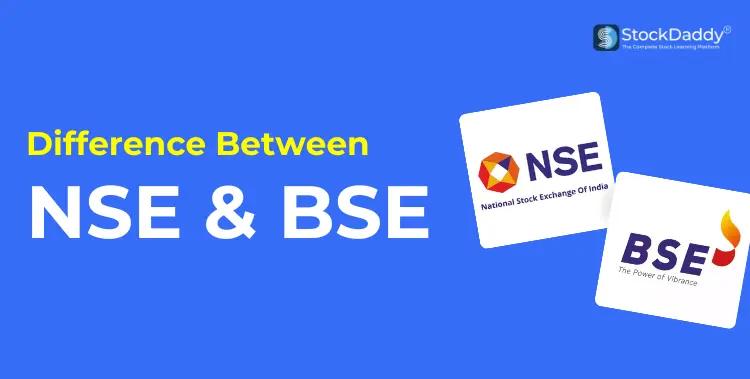Blog >
What is the Difference Between NSE and BSE
What is the Difference Between NSE and BSE

You must have read about Sensex and Nifty soaring up or crashing down after any positive or negative news circulates in the market. Sensex and Nifty are the indices of NSE (National Stock Exchange) and BSE (Bombay Stock Exchange) respectively and their upward and downward movement indicates the economic sentiment of any country.
What is NSE and BSE in share market?
There are total 9 stock exchange registered with the SEBI in India. NSE and BSE are the primary stock exchange platforms where investors and traders buy and sell securities and other financial assets with the assistance of brokers.
These are the platforms which facilitate companies to raise funds, investors and traders to make profit by exchanging shares and overall functioning of the market. Although both the platforms perform similar functions, they are different to each other in many aspects. In this let's understand the primary differences between NSE and BSE:
Key Differences between NSE and BSE
| NSE | BSE | |
| Definition | National Stock Exchange also known as NSE is India’s biggest stock exchange that has a screen-based trading system which is fully automated and electronic. | Bombay Stock Exchange, popularly known as BSE, is the oldest and most modern Indian stock exchange which is known for its high speed and efficiency. |
| Founding date | NSE came into being in the year 1992. | BSE was established back in the year 1875. |
| Indices | Nifty 50 is the benchmark index of NSE which tracks the top 50 companies of the platform. | Sensex is the benchmark index of BSE which tracks the top 30 companies on the platform. |
| No. of Companies | There are a total of 2671 companies which are listed on the NSE. | BSE comprises of a whopping 5505 companies listed on it. |
| Trading Network | NSE has a widespread network in more than 1500 cities. | On the other hand, BSE has its presence in 450 cities. |
| Market Cap | As of Jan 2025, NSE has a market capitalization of INR 446 Lakh Crore. | BSE has a market capitalization of INR 305 Lakh Crore. |
| Products | Various financial instruments are traded on NSE including equities currencies corporate bonds mutual funds traded funds initial public offerings (IPOs) institutional placement program(IPPs), offers for sale security lending & borrowing schemes |
The financial assets traded on BSE are equities, currencies, mutual funds, traded funds, corporate bonds, initial public offerings (IPOs), commodity derivatives, offers for sale. |
Simultaneously also know how to learn stock market trading in India
What is NSE?
NSE (National Stock Exchange) established in the year 1992 and is located in Mumbai. Although formed in 1992, it was recognized by SEBI a year later and commenced buying trading in 1994. At first it started operations with wholesale debt market but later also added cash market segment in its operations.
NSE was India's first dematerialized stock exchange. It was a hi-tech stock exchange with a fully automatic screen-based electronic trading system and up to date trading facilities. NSE is India's largest financial market and world's fourth largest with a market capitalization of $4.63 trillion.
The primary index of Nifty is Nifty50 which it launched in 1995-96 and it tracks the top 50 companies listed on the platform. Apart from Nifty50, it also has other important indexes such as Nifty Next50, Nifty500, Nifty Midcap150, Nifty Smallcap250 and Nifty Mid-Small cap 400. Nifty has a range of product offerings such as equity and equity derivatives, currency derivatives, and commodities.
What is BSE?
Bombay Stock Exchange popularly known as BSE is Asia's oldest stock exchange. It was founded in 1875 and was initially known as 'The Native Share & Stockbrokers Association'. Located in Dalal Street, Mumbai, BSE is also the world's tenth largest stock exchange with more than 5505 companies and a market capitalization of $4.3 trillion.
BSE offers a diverse range of products including equities, equity derivatives, commodities and currency derivatives. Senex is the primary index of BSE which tracks the top 30 companies registered on the platform.
Apart from Sensex, it also has other key indexes which tracks other sectors and companies such as BSE 100, BSE 200, BSE 500, BSE MIDCAP, BSE SMLCAP, BSE PSU, BSE Auto, BSE Pharma, BSE FMCG, and BSE Metal.
Which stock exchange is better for you?
If we talk about which stock exchange you should go for it depends on your degree of experience. If you are just starting your investment journey and want to invest in new companies, then you can choose BSE whereas if you're a seasoned investor then you can go for NSE. Otherwise, if you are trading in derivatives, futures and options then you can prefer NSE as it is better equipped for high-risk transactions. However, trading in the stock market without knowing how stock market works can be detrimental therefore it’s important to learn the nuances of stock market before trading.
Also, both the exchanges have different methods of taxation, so if you are earning less return then NSE could make more sense to you and vice versa. At last, both are the top stock exchanges of India and provide secure and fair services.
Conclusion
It is essential to go through the key features of both BSE and NSE before making an investment decision. The choice simply depends on the companies listed in each exchange. Studying the difference between them may help investors make this choice. In the final analysis, there's no such thing as a better exchange. It's just a matter of finding the best fit for your investment goals, risk appetite, and trading preferences.
FAQ
Ques 1. How many stocks are listed in NSE?
Ans. There are a total of 2671 stocks which are listed on the NSE.
Que 2. How many companies are listed in BSE?
Ans. BSE comprises of a whopping 5505 companies listed on BSE.
Ques 3. can i buy in nse and sell in bse?
Ans. Yes, it is possible to buy a stock on one stock exchange and sell it on the other. It is because of the facility of interoperability among clearing corporation of various stock exchanges. It facilitates trade on any stock exchange as it can be settled through a single clearing corporation.
Ques 4. How to check delivery percentage of stock in nse?
Ans. Percentage of shares actually delivered as opposed to being traded is an important metric that indicates the percentage of shares delivered to the buyer which were traded. You can go the NSE website and write the name of the stock on the search bar of the homepage. Click on the stock and on the stock page you'll come across various tabs like Overview, Historical Data, etc. Here click on historical data where one of the column will be of % of Deliverable Quantity to Traded Quantity. You can check the delivery quantity percentage of the stock there.

- Recent Blogs
- What is gold Bees ETF and How to invest in it?
- Difference Between Call and Put Option
- Types of Charts in Stock Market
- what is CPSE etf and How is it a good investment Opportunity
- What is Margin Trading Facility
- why Tata Motors Share is Falling?
- Disadvantages of SIP Investment You Should Know
- Can Stock Market make you Rich?
- Difference Between Sensex and Nifty
- Difference Between Fundamental Analysis and Technical Analysis